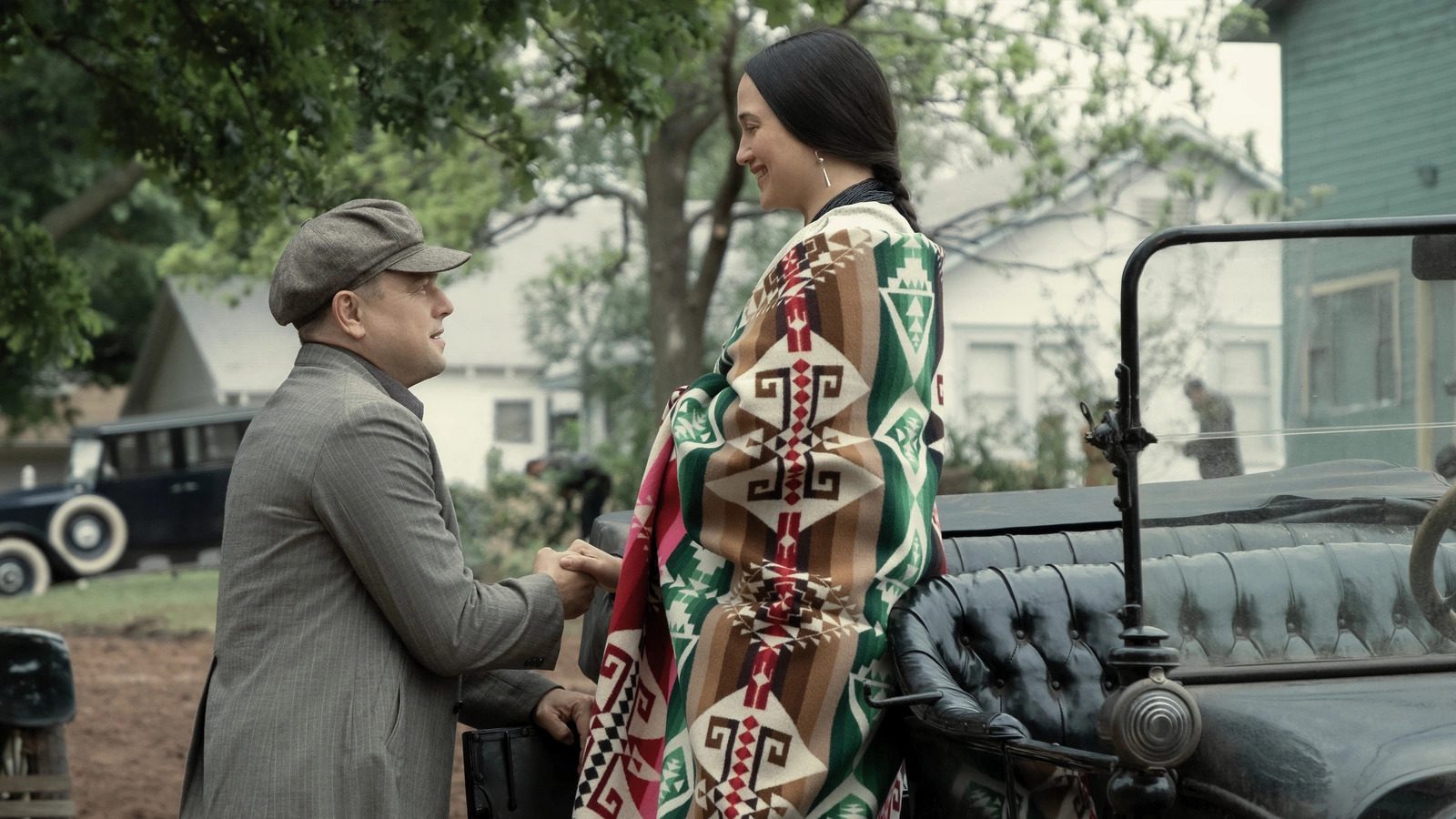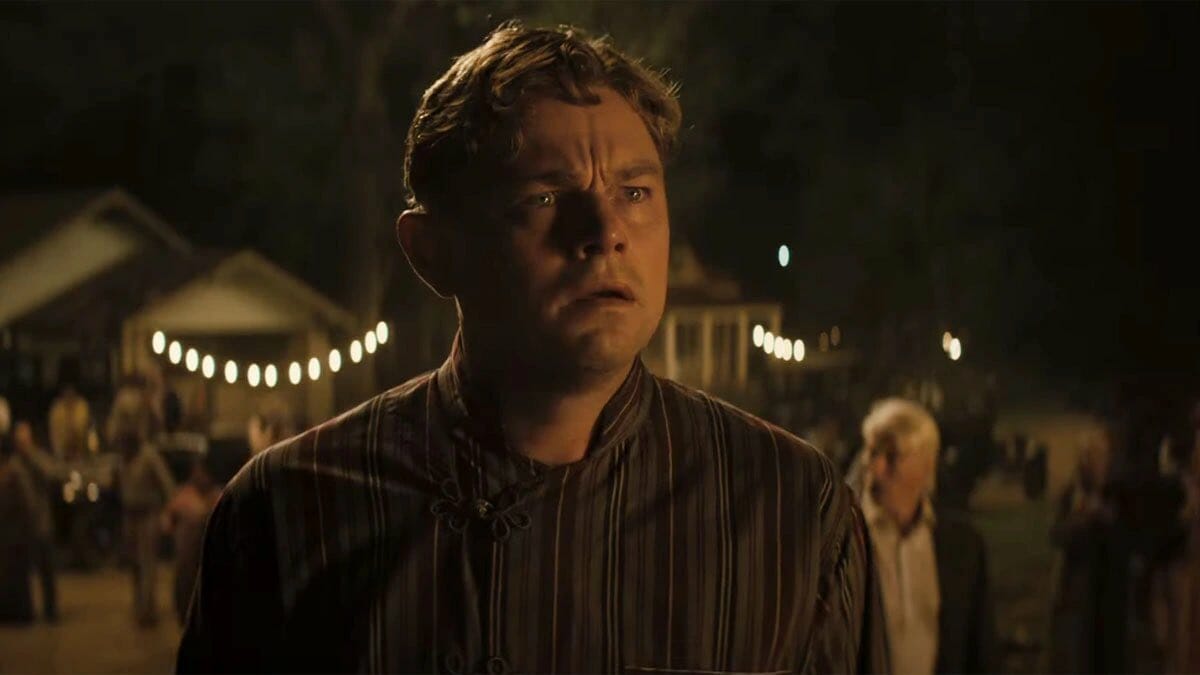REVIEW: Killers of the Flower Moon (2023)
Killers of the Flower Moon is Martin Scorsese taking his time. It doesn’t have the frenetic energy of some of the films for which he’s most famous, but its intimate, slow-burn story reveals itself gradually, slowly setting the stage for a rumination on the nature of evil. And it’s done with an emphasis on the characters, on what greed, gullibility, and dehumanization can bring out in people.
The Osage Nation, a Native American community in Oklahoma, has struck oil, to the great benefit of its people. But wealthy captains of industry, particularly William Hale (Robert De Niro), want the money for themselves and have made inroads into the Osage. Hale’s nephew, Ernest Burkhart (Leonardo DiCaprio), is back from World War I and goes to work for his uncle as a driver until he meets and falls in love with Mollie (Lily Gladstone), a wealthy Osage woman. Meanwhile, a series of murders plague the Osage Nation.
The opening scenes of Killers of the Flower Moon depict a dynamic we’re not used to seeing in movies. The Native Americans of Osage are wealthy and happy thanks to the oil found under their land. They drive around in fancy cars and wear fine clothes as they wave American flags. It’s the white men, the outsiders to Osage, who behave in stereotypical ways, getting drunk, fighting, committing crimes, and being drains on a society that has pulled itself out of poverty. At the top of this heap is William Hale, a wealthy cattle baron who wants to milk the Osage for all they’re worth. Wisely, Killers of the Flower Moon doesn’t make it a racial conflict; there are undercurrents of that, but the story is mainly about the wealthy trying to take advantage of anyone who has money they can snatch for themselves. For example, the white men who marry Osage women brag about them being “full-blooded,” but this isn’t because of any racial implications but to signify how much money they bring with them.
Those swept up in Hale’s greed range from his victims among the Osage to the otherwise ordinary people he gets to do his dirty work for him. Ernest is one such, a dopey ne’er-do-well who can’t cut it anywhere but in his uncle’s employ. DiCaprio is playing a wildly different role yet again, and he’s terrific largely because he keeps much of Ernest’s motivations a mystery. Even after the movie is over, you’re not quite sure why he did certain things or how he feels about certain people; in fact, you’re not even sure if he knows. Robert De Niro is similarly playing a cagey character; although Hale’s motivations are clear, he communicates his intentions cryptically, never saying what he’s clearly implying… at least until things get desperate. Lily Gladstone differs from both men in that she makes Mollie’s feelings obvious. An early scene where she and DiCaprio flirt during a car ride is masterful; he’s laying on the charm, and she knows exactly what he’s doing, but she can’t help finding it endearing anyway. As always, Scorsese gets the very best out of his actors.

And they’ve got a lot to work with because Killers of the Flower Moon tackles some disturbing themes. This is an examination of the nature of evil, and it spreads from the lofty heights of a wealthy man like William Hale to regular folks like you and me. What can greed do to someone who would otherwise have left others alone? What is a man capable of doing to his own family? How blinded can we be to an evil we know in the back of our minds exists when it’s coming from someone we trust above all others? And maybe most disturbing of all, can we ever truly know what motivates us to hurt others? This is not an easy movie to watch in places, not so much for the violence itself (although it’s there, and in typical Scorsese fashion, often comes suddenly and without warning) but for the ideas that bring forth that violence. The music helps set the stage for this as well, with folk tunes emphasizing the ordinary people of the Osage Nation and how darkness is being committed by and perpetrated upon them. The best comparison I can make is to the songs in Oh Brother, Where Art Thou?
The filmmaking is stellar, which, of course, is a given. There are very wide shots early on reminiscent of those winding shots of the desert outside Las Vegas in Casino. Instead of showing us where the bodies are buried, the ones in Killers of the Flower Moon lay out the massive land the Osage controls and how tempting it is to plunderers like William Hale. As the movie unfurls, the film language becomes subtler, with demonstrations of the characters’ feelings in things like a shattered glass door or a movement in bed. The murders are committed at a distance, making us casual observers of violent crimes, never a part of them but having them thrust upon us. The culture clash between Ernest and Mollie is demonstrated in a simple but perfectly staged scene where they both sit at a dining room table, one at home in the scene and the other wondering what to do with himself while something he doesn’t understand plays out. Scorsese can do a lot with a lot or a lot with a little, and he does both here.

Killers of the Flower Moon is another great film from Martin Scorsese. I’ve seen it hailed as a masterpiece elsewhere, and I wouldn’t go that far; this isn’t quite on the level of his very best movies. Even among his recent output, I liked The Irishman more. But it’s an impeccably acted, beautifully filmed look at the darkness humanity is capable of, the inevitability of greed-induced exploitation, and the struggles of good people to comprehend the evil in their midst, especially when it’s in their own family. My screening opened with Scorsese thanking the audience for seeing Killers of the Flower Moon in a theater, and you’re much better off doing the same.
Killers of the Flower Moon (2023)
Plot - 9
Acting - 10
Directing/Editing - 9
Music/Sound - 8
Themes - 10
9.2
Great
Killers of the Flower Moon is a deliberately paced meditation on the nature of evil and good people’s reaction to it, with stellar performances and expert filmmaking from one of the world’s best directors.








Seen the movie too; great movie. My favorite Scorsese movie is The Departed! Have you seen that?